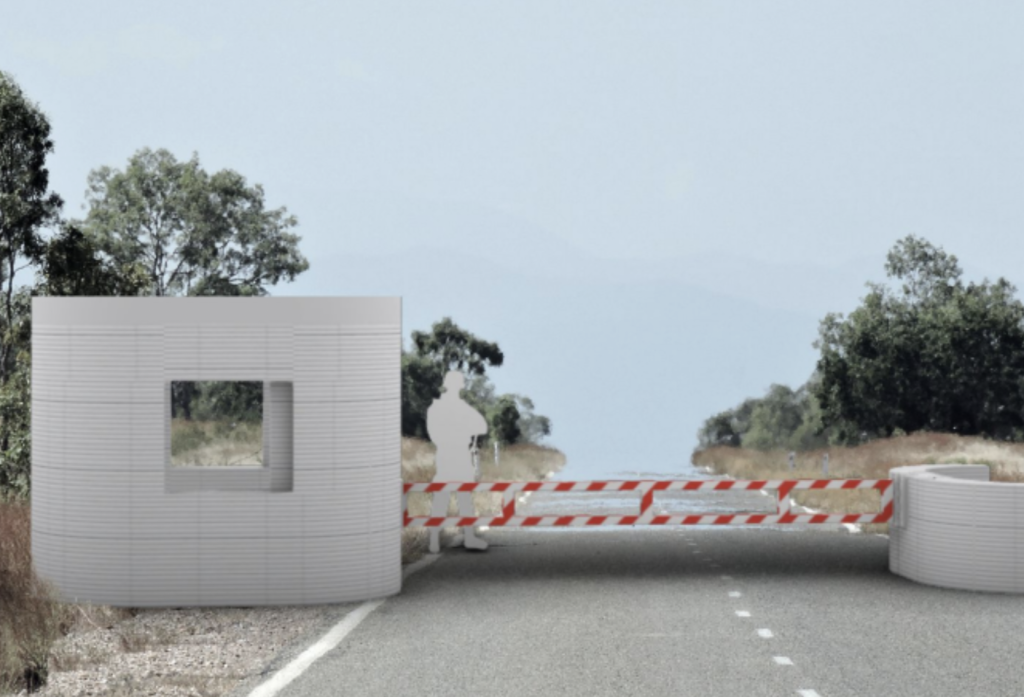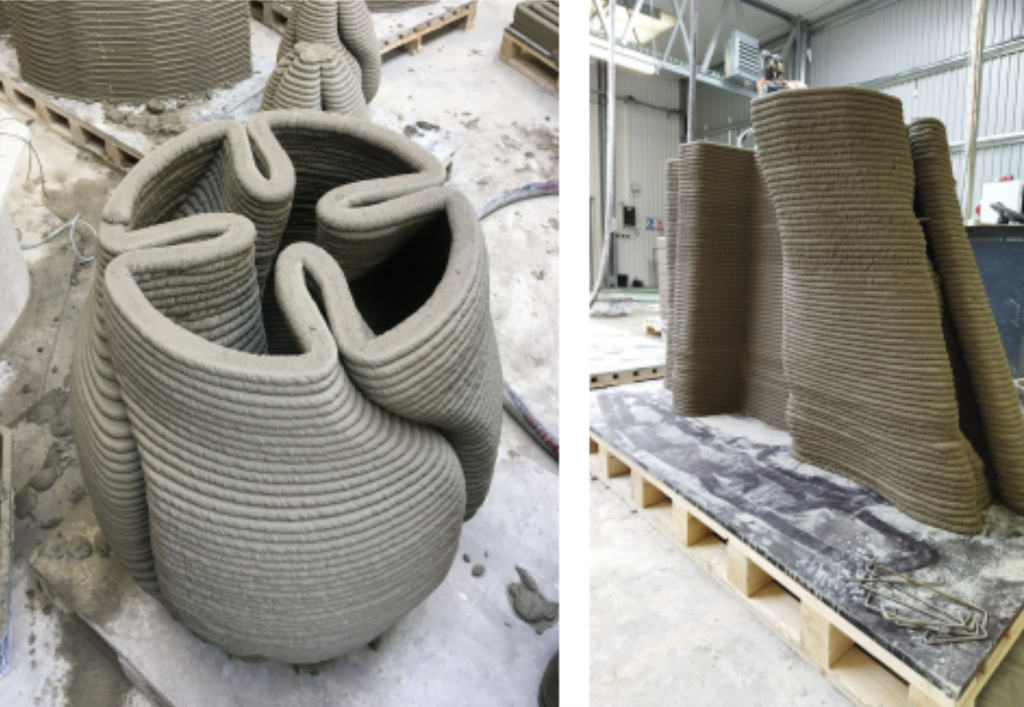Czech industrial automation specialist ICE Industrial Services has announced plans to begin using in-house-developed technology to begin rebuilding parts of war-torn Ukraine.
Composed of a novel concrete-depositing printhead, that can be suspended from either a robotic arm or gantry, the firm’s system is said to enable the 3D printing of structures with uniquely robust nature-inspired designs.
Speaking to 3D Printing Industry, the company’s CEO Tomáš Vránek has now revealed that it intends to deploy this technology to rebuild military barriers and checkpoints across the country, with the aim of protecting Ukrainian soldiers.
“What we were trying to achieve was to build the first 3D printed house in the Czech Republic, and with the situation in Ukraine, it just came as an opportunity,” explained Vránek. “We saw that they have sandbags everywhere and are hiding behind old cars, so we just thought, ‘let’s help them.’ Our architects and designers then came up with some shapes that should work to absorb bullet attacks.”

ICE’s unique 3D printing approach
Based in Prague, ICE Industrial Services is better known for designing, planning, engineering, building, and animating automated machinery, than it is for 3D printing. That being said, according to Vránek, the firm has recently begun to explore ways of “differentiating itself” due to both the impact of COVID-19, and the level of competition around supplying automotive clientele, which gets “quite nasty.”
With this in mind, ICE Industrial Services’ R&D department identified 400 areas of opportunity, before narrowing these down, with concrete 3D printing ultimately winning out. Aiming to modernize the house building process, something Vránek suggests is basically the “same as that used to build the pyramids,” the company has therefore opted to come up with its very own concrete printhead.
Packed with thirty different sensors, the device transmits data on the moisture, heat, warmth, and shape of layers to operators in real-time, as they’re printed. However, having accepted that ordinary concrete just wouldn’t be suited to construction 3D printing, the ICE Industrial Services team has also chosen to work with colleagues at the Brno University of Technology, to develop a custom material.
Much like the admixture-boosted concrete created by COBOD and CEMEX late last year, as well as ICON’s proprietary Lavacrete 3D printing material, the company’s concrete is considered, in the words of Vránek, part of the innovation that’s “hidden inside” the system, which makes it stand out against traditional competitors.
Another aspect of ICE Industrial Services’ technology that Vránek considers to be a USP, is the team of experts behind its operation. Working with colleagues, which the CEO describes as some of the “Czech Republic’s leading parametric design experts,” he says his firm has been able to build self-supporting gyroid-shaped structures with geometries that “really utilize the advantages of 3D printing.”
“If you look at the house COBOD built in Germany, they just printed an ordinary squared house with right angles,” claimed Vránek. “This denies the advantages of 3D printing, which lets you print nice shapes that are inspired by nature and carry themselves.”
“Our biggest uniqueness lies in the real concrete we use and our team of architects, one of which has worked with Zaha Hadid, possibly the number one architect of the last few years.”

Answering Ukraine’s call for support
In light of the current situation in Ukraine, and having found that its technology is capable of creating buildings with patterned layers that make them highly resilient, ICE Industrial Services has recently begun to experiment with 3D printed barricades.
Specifically, by filling the gaps between walls with a combination of sand and tunable sandwich structures, the firm has found it possible to provide them with different degrees of reinforcement. While these structures are still undergoing ballistic testing, and Vránek admits they wouldn’t survive heavy artillery fire, he maintains that they’ve shown promise, particularly in resisting machine gun fire.
“They mostly offer protection against infantry attacks, if some rockets or a tank hit it then you have no chance behind any kind of cover,” explained Vránek. “We didn’t even test them against Kalashnikovs and submachine guns, as the guns wouldn’t do anything, so we had some really strong results, mostly due to this sandwich structure.”
Over recent weeks, ICE Industrial Services’ experiments have started to attract global coverage, and even caught the attention of the Ukrainian government. Having exchanged letters with Prime Minister Denys Shmyhal, the firm has now been invited to present its technology to state officials, with a view to using it as a means of rebuilding the checkpoints destroyed in Russia’s invasion.
In the days to come, Vránek says the company plans to ship its first samples to Ukraine for research purposes, with the long-term aim of establishing a 20-system base there, and 3D printing on-site. Ultimately, Vránek adds that these could not only be used for military purposes, but even civilian ones, in the erection of “less demanding structures” that meet the immediate needs of Ukrainians.

Although ICE Industrial Services’ aspiration to apply construction 3D printing inside a conflict zone is fairly unique, it’s far from the first time the technology has been used to protect military personnel. ICON has previously worked with the Texas Military Department to 3D print training barracks, designed to house US troops during exercises.
Similarly, General Lattice has been awarded a contract to improve the impact absorption of US Army helmets using 3D printing and advanced lattice geometries. Through the ongoing research project, the firm aims to develop a predictive modeling toolset that helps it design and generate superior lattice materials for making military headgear.
Away from the world of construction 3D printing, the technology has more often been deployed in training by armed forces around the world, to experiment with its capability to deliver spares and repairs on-demand. The Australian Army has field-tested SPEE3D’s 3D printers extensively in this area and reported carrying out at least one such exercise late last year, in the country’s remote Northern Territory.
To stay up to date with the latest 3D printing news, don’t forget to subscribe to the 3D Printing Industry newsletter or follow us on Twitter or liking our page on Facebook.
For a deeper dive into additive manufacturing, you can now subscribe to our Youtube channel, featuring discussion, debriefs, and 3D printer reviews.
Are you looking for a job in the additive manufacturing industry? Visit 3D Printing Jobs for a selection of roles in the industry.
Featured image shows a mock-up of a ICE Industrial Services 3D printer barricade. Image via ICE Industrial Services.



